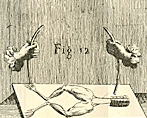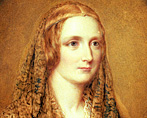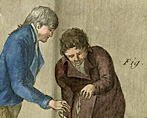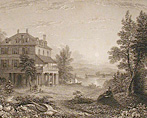Education
Frankenstein: Penetrating the Secrets of Nature presents the following classroom resources for K-12 and undergraduate educators and their students. The resources offer templates for incorporating the exhibition’s scholarly content in order to help students learn by examining and analyzing primary- and secondary-source visual and textual materials. They promote students’ consideration of science and society as a whole and develop historical perspectives on how scientific endeavors influence as well as are shaped by society and culture. Educators are welcome to adapt these resources in whole or in part as they deem appropriate for students’ interests and learning goals.
Lesson Plans
Electricity, Frankenstein, and the Spark of Life
- grade level: 6–8 | subject: literature and science & technology
Students examine the references to electricity by reading short excerpts from Chapters 2 and 5 of the Frankenstein novel and by watching a four-minute clip of the 1931 film version of Frankenstein. They compare the two and identify how similarly or differently the novel and film depict the scientist and his knowledge and use of electricity in creating his monster. Students then learn about Luigi Galvani and Alessandro Volta, two scientists who experimented with and advanced the study and understanding of electricity during late 1700s.
Frankenstein’s Science
- grade level: 9–11 | subject: literature and science & technology
Students assess their assumption about what “Frankenstein” represents and compare them to what they learn from the original novel published in 1818 and the film from 1931. They explore the popular scientific works during the two different times when the novel and the film were created. Students use both the information text and visual items from the online exhibition in identifying examples of science topics that possibly informed the writing of the novel and making of the film. They then apply their understanding to identify and research current debates on science and technology.
The lesson plans have been developed in collaboration with the following classroom teachers, who reviewed and provided valuable comments for finalizing the lessons: Terence Nickie (Boulder Community School of Integrated Studies, CO), Scott Allen (Monarch High School, Boulder, CO), and Janet Collier (Jewish Primary Day School of the Nation’s Capital, Washington, DC).
Higher Education
Following Frankenstein: Mary Shelley, The Monster, and Medical Science
The module examines the scientific and medical milieu which informed Mary Shelley’s creation of a young student of nature and his monster, and the ways in which this creation continues to speak to contemporary responses to biomedical innovations. A selection of secondary- and primary-source class materials guide students to explore questions, such as how Mary Shelley might have drawn on developments in medicine and science to create her novel; What Mary Shelley intended by selecting the book’ subtitle, The Modern Prometheus; and why Shelley’s novel (originally published in 1818) continue continues to resonate so strongly with readers in the 20th and 21st centuries, among others.
Following Frankenstein: Mary Shelley, The Monster, and Medical Science is authored by Susan E. Lederer, PhD, the Robert Turell Professor of the History of Medicine and Bioethics at the University of Wisconsin School of Medicine and Public Health.
Online Activities
Science: Perfusion & Transfusion
What are the “glass heart” and “gravitator”? Examine their images in the digital gallery and learn about who invented them and how they work.
Other Resources
Continue to explore topics related to the Frankenstein story, Mary Shelley, and scientific developments from Shelley’s time to the present, with these lists of suggested K-12 readings and online resources, and a curator’s bibliography.
Continue to Other Resources






